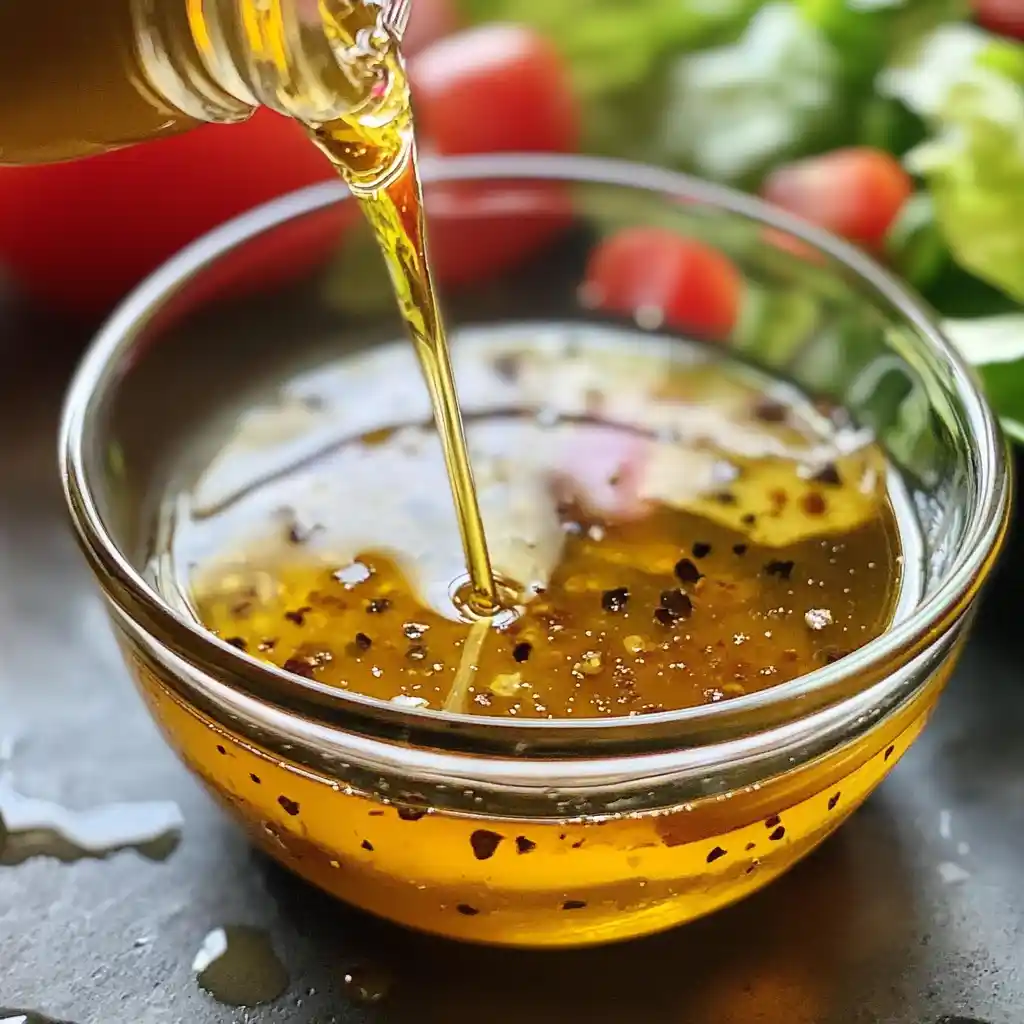Vinegar and Oil Salad Dressing Recipe

When it comes to salad dressings, nothing beats the simplicity and timeless flavor of a vinegar and oil salad dressing recipe. Known around the world as the foundation of vinaigrettes, this dressing requires only a few pantry staples yet delivers bold, tangy, and refreshing flavor. It’s versatile enough to complement green salads, pasta salads, roasted vegetables, or even grilled proteins.
Homemade dressings are not only fresher and tastier but also healthier than store-bought versions since you have full control over ingredients. By adjusting the ratio of vinegar to oil, adding herbs, or experimenting with different vinegars and oils, you can customize it to suit your taste buds perfectly.
This article will guide you step by step through making the perfect vinegar and oil dressing, along with tips, variations, and serving ideas so you can elevate your meals effortlessly.
💖 Why You’ll Love This Recipe?
- Quick & Easy: Just whisk together pantry staples in less than 5 minutes.
- Healthy Choice: Made with heart-healthy oils and no artificial preservatives.
- Customizable: Adaptable with herbs, spices, garlic, mustard, or even honey.
- Budget-Friendly: No need for expensive bottled dressings.
- Multi-purpose: Works for salads, marinades, and dipping sauces.
🛒 What Do You Need to Prepare Vinegar and Oil Salad Dressing?
Here’s a basic list of ingredients for the perfect balance of tangy and smooth:
- Vinegar (3 tbsp): Red wine vinegar, apple cider vinegar, balsamic vinegar, or white wine vinegar.
- Olive Oil (9 tbsp): Extra virgin olive oil is most common, but avocado oil or sunflower oil work well too.
- Salt (½ tsp): Sea salt or kosher salt for flavor balance.
- Black Pepper (¼ tsp): Freshly ground for the best taste.
- Optional Add-ins:
- Dijon mustard (1 tsp) for creaminess and tang.
- Garlic (1 clove, minced) for a punch of flavor.
- Dried oregano or basil (½ tsp) for Mediterranean flair.
- Honey (1 tsp) for mild sweetness.
👩🍳 How to Make Easy Vinegar and Oil Salad Dressing Step-by-Step ?
Step 1: Choose Your Vinegar
Pick your preferred vinegar—apple cider for fruitiness, balsamic for sweetness, or red wine vinegar for a sharp tang.
Step 2: Measure the Oil
Use three parts oil to one part vinegar for the best balance. Olive oil is the classic choice for richness.
Step 3: Mix the Base
In a small bowl or jar, whisk together vinegar and oil until slightly emulsified.
Step 4: Add Seasoning
Stir in salt, black pepper, and any additional flavor enhancers like Dijon mustard or minced garlic.
Step 5: Shake or Whisk
Transfer to a jar with a lid and shake vigorously, or whisk until ingredients blend into a smooth dressing.
🌿 Variations
One of the best things about a vinegar and oil salad dressing is how flexible it is. You can customize it endlessly to suit your taste or the type of salad you’re preparing. For a Mediterranean-style vinaigrette, add dried oregano, lemon juice, and a touch of garlic. If you prefer a sweeter profile, try adding honey, maple syrup, or even a splash of orange juice. For a spicy kick, whisk in a pinch of red pepper flakes or a dash of hot sauce.
Different oils completely change the character of the dressing. For instance, walnut or hazelnut oil adds a nutty flavor that pairs beautifully with fruit salads, while avocado oil creates a mild and creamy texture. Similarly, vinegars offer unique personalities—balsamic gives richness, apple cider vinegar adds a fruity zing, and rice vinegar creates a lighter, Asian-inspired taste.
Experiment with fresh herbs like basil, parsley, cilantro, or thyme to bring a garden-fresh flavor to your vinaigrette. You can even blend the dressing for a smoother texture or add a spoonful of Greek yogurt to make it creamy. Each variation adds a new dimension to the classic base, making it endlessly exciting.
🍳 Cooking Note
Even though this dressing requires no actual cooking, there are a few important points to keep in mind to ensure the best results. The quality of your ingredients directly affects the flavor of your dressing. Always use high-quality extra virgin olive oil and vinegar, as cheaper versions can taste harsh or flat.
The oil-to-vinegar ratio is usually 3:1, but this isn’t set in stone. If you prefer a tangier dressing, increase the vinegar; for a milder flavor, use more oil. Always taste and adjust as you go along. To achieve a well-blended dressing, whisk or shake thoroughly before serving, as oil and vinegar naturally separate over time.
If you include add-ins like garlic, herbs, or mustard, make sure they are finely minced or blended for a smooth consistency. Store your dressing in a clean, airtight jar in the refrigerator. Since it contains fresh ingredients, try to use it within a week for the best flavor. Remember to shake it again before each use, as natural separation will occur.
🍽️ Serving Suggestions
This classic vinegar and oil salad dressing is incredibly versatile. The most common use is as a dressing for leafy green salads—romaine, arugula, spinach, or a simple garden salad. It’s equally delicious drizzled over pasta salads, grain bowls, or roasted vegetables. You can also use it as a marinade for chicken, beef, pork, or fish before grilling.
Pair it with a crusty baguette as a dipping sauce, or drizzle over fresh mozzarella and tomatoes for a quick Caprese-style salad. Another great idea is tossing it with steamed vegetables or cooked beans for a quick, healthy side dish. This simple dressing adapts beautifully to nearly any meal.
💡 Helpful Tips
- Use fresh, quality ingredients: Good olive oil and vinegar make a world of difference.
- Balance the flavors: Always taste-test and adjust salt, pepper, or vinegar to your liking.
- Make in small batches: Fresh dressing tastes better, so prepare enough for a week at most.
- Store properly: Keep it in a tightly sealed jar in the fridge; shake before using.
- Emulsify well: A teaspoon of mustard or honey helps keep the oil and vinegar blended.
- Experiment with herbs: Fresh herbs like basil, thyme, or parsley elevate the flavor.
- Add citrus: A squeeze of lemon or lime can brighten the dressing.
- Double it as a marinade: Perfect for meats, seafood, or grilled vegetables.
🥄 Tips for the Best Vinegar and Oil Salad Dressing
For the absolute best dressing, start with high-quality extra virgin olive oil and aged vinegar. Always whisk or shake vigorously just before serving to ensure proper blending. To avoid overpowering flavors, don’t add too much garlic or mustard—less is more. If making ahead, prepare the base without fresh garlic or herbs; add those right before serving to keep them vibrant.
If your dressing tastes too sharp, balance it with a hint of honey or maple syrup. For added depth, try combining two vinegars, like balsamic with apple cider. Always remember that the dressing should complement your salad ingredients, not overwhelm them.
🕒 Timing Overview
- Prep Time: 5 minutes
- Cooking Time: 0 minutes
- Total Time: 5 minutes
🧾 Nutritional Information (per 2 tbsp serving)
- Calories: 120
- Protein: 0g
- Sodium: 75mg
- Fat: 13g
- Carbohydrates: 1g
- Fiber: 0g
- Sugar: 0g
❓ FAQs
Q1: What is the best oil to use?
Extra virgin olive oil is most common, but avocado oil, walnut oil, or grapeseed oil are excellent alternatives.
Q2: Can I make this dressing ahead of time?
Yes! Store it in a sealed jar in the refrigerator for up to 1 week. Shake well before using.
Q3: How do I make the dressing less tangy?
Simply increase the oil ratio or add a touch of honey or maple syrup.
Q4: Can I freeze vinegar and oil dressing?
Freezing is not recommended since oil solidifies; it’s best made fresh.
🏁 Conclusion
A vinegar and oil salad dressing recipe proves that simple ingredients can create bold, memorable flavors. It’s the foundation of countless salads, marinades, and side dishes, offering versatility and health benefits. By mastering this classic recipe, you can say goodbye to store-bought dressings and enjoy fresh, homemade flavors tailored to your taste.
Whether you prefer tangy, sweet, herby, or spicy, this vinaigrette can adapt to every occasion. Next time you reach for bottled dressing, try whisking together your own instead—you’ll taste the difference immediately.

